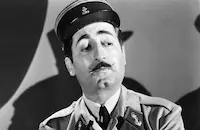Previously released in the United States in 1959 in a severely edited form entitled Journey to the Lost City, Fritz Lang's Indian epic is now available in its entirety thanks to the dedicated efforts of the film purists at Fantoma. Originally, Lang intended his epic to be seen in two parts - The Tiger of Eschnapur and The Indian Tomb - and that's the way it was distributed in Germany where it was a huge boxoffice success. This ambitious production marked the first time Lang had made a film in his native country since a two-decade exile in America but European critics were rather harsh in their assessment of the film. They saw it as a waste of Lang's talent and wrote it off as kitsch. The American distributors likewise saw it as a colorful but routine adventure which was ideal for undiscriminating juvenile audiences. So, they reduced its original running time from 201 minutes to 90 minutes, dubbed it into English, and made Debra Paget, the only American actor in the cast, the focus of their ad campaign. Not surprisingly, it was poorly received in its butchered form by most critics of any influence but Debra Paget's exotic dancing certainly made an impression on a lot of eleven-year-old boys - one of whom was probably Steven Spielberg whose later Indiana Jones series was obviously influenced by the sets and the exotic atmosphere of Lang's epic.
Seen today The Tiger of Eschnapur and The Indian Tomb are revelations and it's hard to believe that the German critics didn't see the importance of these films on their original release. Tom Gunning, who teaches film at the University of Chicago, wrote the liner notes for both DVDs and his comments are particularly insightful. He writes that in order to appreciate both films, "you must let yourself be absorbed into an unreal world realized by a master of cinematic style. But if the film is mythic, it is not childish. Lang creates a double world in which shining surfaces cloak a sinister core. Initially the gleaming white palace courtyards and expensive apartments appear gorgeous and colorful, with Lang's architectural vision reveling in sets whose rich patterns often overwhelm the characters. But, increasingly, the typical Lang paranoia sets in. The bright apartments become prison cages and the gleaming palaces rest over a decadent maze of caves, underground lakes and tunnels, a realm of death guarded by corpses and inhabited by the living dead."
One person who certainly saw the dark side of Lang's epic was lead actress Debra Paget. In an interview with Tom Weaver for his book, Science Fiction and Fantasy Film Flashbacks (McFarland Press), she discussed the difficulties of filming on location in India (there were HUGE rats everywhere - her bedroom for instance) and her provocative costume in the dance scene with the cobra god. Regarding the latter she said, "..if Fritz had his way, it would have been less. Actually, one costume was just glued on. It was like a bikini, but there were no straps - they glued it on with a marvelous glue called Uhu. In fact, we used to call it "the Uhu movie" because earrings were glued on, everything was glued on, they'd just bring out the Uhu! The costume was actually glued on me and I danced in it. Any little move and we just had to cut and grab and re-glue me. And the only thing which would take that glue off was benzene, which is gasoline. By the third day, I was just like raw hamburger, everywhere. It was a mess." On-screen, however, Paget's beauty is flawless and her dance scenes are a mesmerizing combination of eroticism and high camp.
Fantoma's transfers of The Tiger of Eschnapur and The Indian Tomb are works of art (the DVDs were digitally mastered at American Zoetrope DVD lab). The clarity of every single frame of each film is amazingly clear and sharp. It's hard to imagine that either film ever looked this look even during its theatrical run. As for the special features, you can have a choice of English language versions or German dialogue with English subtitles. There are also some intriguing photo galleries with rare stills, posters, and behind the scenes photographs. Both discs are highly recommended. For more information about The Tiger of Eschnapur and The Indian Tomb, visit Fantoma and Image Entertainment, Inc..
By Jeff Stafford
The Indian Tomb
Brief Synopsis
A jealous Maharajah discovers that the girl he loves is in love with a visiting German architect, captures her, and threatens to bury her alive as punishment.
Cast & Crew
Read More
Fritz Lang
Director
Angela Portulari
Paul Hubschmid
Sabina Bethmann
Jochen Blume
Claus Holm
Film Details
Also Known As
Das Indische Grabmal: Der Tiger von Eschnapur, Das indische Grabmal, Indian Tomb, Indische Grabmal: Der Tiger von Eschnapur, Tomb of Love, The
Genre
Adaptation
Adventure
Release Date
1959
Technical Specs
Duration
3h 18m
Color
Color (Eastmancolor)
Synopsis
A jealous Maharajah discovers that the girl he loves is in love with a visiting German architect, captures her, and threatens to bury her alive as punishment.
Director

Fritz Lang
Director
Cast
Angela Portulari

Paul Hubschmid
Sabina Bethmann
Jochen Blume
Claus Holm

Victor Francen
Walther Reyer
Jochen Brockmann

Debra Paget
Richard Lauffen
René Deltgen
Guido Celano
Panos Papadopoulos

Luciana Paluzzi
Valery Inkijinoff
Helmut Hildebrand
Crew
Richard Angst
Other
Richard Angst
Director Of Photography
Gerhard Becker
Music
Artur Brauner
Producer
Louise Demasure
Producer
Robby Gay
Choreographer
Fritz Lang
Writer (Adaptation)
Fritz Lang
Screenplay
Werner Jorg Luddecke
Screenplay
Eberhard Meischner
Producer
Michel Michelet
Music
Helmut Nentwig
Art Director
Willi Schatz
Art Director
Thea Von Harbou
Source Material (From Novel)
Walter Wischniewski
Editor
Film Details
Also Known As
Das Indische Grabmal: Der Tiger von Eschnapur, Das indische Grabmal, Indian Tomb, Indische Grabmal: Der Tiger von Eschnapur, Tomb of Love, The
Genre
Adaptation
Adventure
Release Date
1959
Technical Specs
Duration
3h 18m
Color
Color (Eastmancolor)
Articles
Fritz Lang's Indian epic - THE TIGER OF ESCHNAPUR & THE INDIAN TOMB

Fritz Lang's Indian epic - THE TIGER OF ESCHNAPUR & THE INDIAN TOMB
Previously released in the United States in 1959 in a severely edited form entitled Journey to the Lost City, Fritz Lang's Indian epic is now available in its entirety thanks to the dedicated efforts of the film purists at Fantoma. Originally, Lang intended his epic to be seen in two parts - The Tiger of Eschnapur and The Indian Tomb - and that's the way it was distributed in Germany where it was a huge boxoffice success. This ambitious production marked the first time Lang had made a film in his native country since a two-decade exile in America but European critics were rather harsh in their assessment of the film. They saw it as a waste of Lang's talent and wrote it off as kitsch. The American distributors likewise saw it as a colorful but routine adventure which was ideal for undiscriminating juvenile audiences. So, they reduced its original running time from 201 minutes to 90 minutes, dubbed it into English, and made Debra Paget, the only American actor in the cast, the focus of their ad campaign. Not surprisingly, it was poorly received in its butchered form by most critics of any influence but Debra Paget's exotic dancing certainly made an impression on a lot of eleven-year-old boys - one of whom was probably Steven Spielberg whose later Indiana Jones series was obviously influenced by the sets and the exotic atmosphere of Lang's epic.
Seen today The Tiger of Eschnapur and The Indian Tomb are revelations and it's hard to believe that the German critics didn't see the importance of these films on their original release. Tom Gunning, who teaches film at the University of Chicago, wrote the liner notes for both DVDs and his comments are particularly insightful. He writes that in order to appreciate both films, "you must let yourself be absorbed into an unreal world realized by a master of cinematic style. But if the film is mythic, it is not childish. Lang creates a double world in which shining surfaces cloak a sinister core. Initially the gleaming white palace courtyards and expensive apartments appear gorgeous and colorful, with Lang's architectural vision reveling in sets whose rich patterns often overwhelm the characters. But, increasingly, the typical Lang paranoia sets in. The bright apartments become prison cages and the gleaming palaces rest over a decadent maze of caves, underground lakes and tunnels, a realm of death guarded by corpses and inhabited by the living dead."
One person who certainly saw the dark side of Lang's epic was lead actress Debra Paget. In an interview with Tom Weaver for his book, Science Fiction and Fantasy Film Flashbacks (McFarland Press), she discussed the difficulties of filming on location in India (there were HUGE rats everywhere - her bedroom for instance) and her provocative costume in the dance scene with the cobra god. Regarding the latter she said, "..if Fritz had his way, it would have been less. Actually, one costume was just glued on. It was like a bikini, but there were no straps - they glued it on with a marvelous glue called Uhu. In fact, we used to call it "the Uhu movie" because earrings were glued on, everything was glued on, they'd just bring out the Uhu! The costume was actually glued on me and I danced in it. Any little move and we just had to cut and grab and re-glue me. And the only thing which would take that glue off was benzene, which is gasoline. By the third day, I was just like raw hamburger, everywhere. It was a mess." On-screen, however, Paget's beauty is flawless and her dance scenes are a mesmerizing combination of eroticism and high camp.
Fantoma's transfers of The Tiger of Eschnapur and The Indian Tomb are works of art (the DVDs were digitally mastered at American Zoetrope DVD lab). The clarity of every single frame of each film is amazingly clear and sharp. It's hard to imagine that either film ever looked this look even during its theatrical run. As for the special features, you can have a choice of English language versions or German dialogue with English subtitles. There are also some intriguing photo galleries with rare stills, posters, and behind the scenes photographs. Both discs are highly recommended. For more information about The Tiger of Eschnapur and The Indian Tomb, visit Fantoma and Image Entertainment, Inc..
By Jeff Stafford
Quotes
Trivia
Miscellaneous Notes
Remake of the silent 1921 film with the same title directed by Joe May.
Film was released in two parts, this being part II. Part I is "The Tiger ofr Eschnapur" released in 1958.













